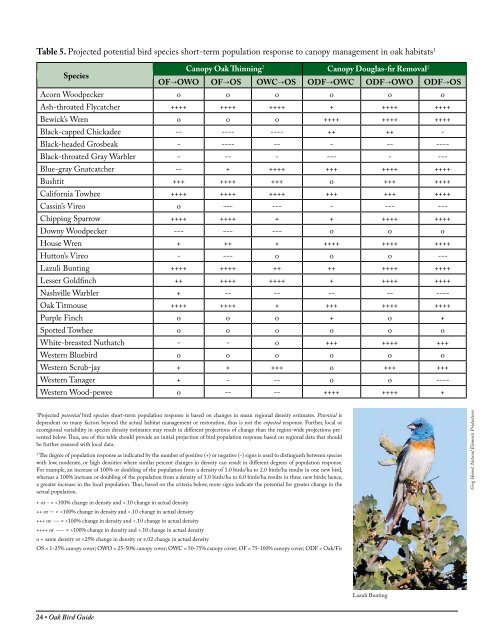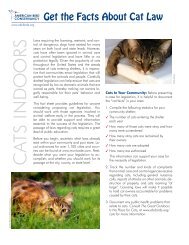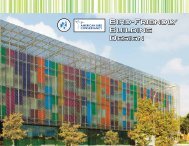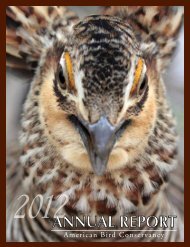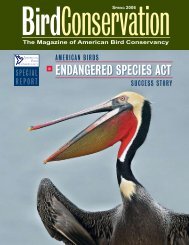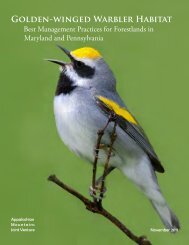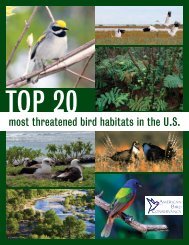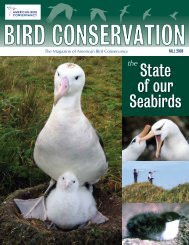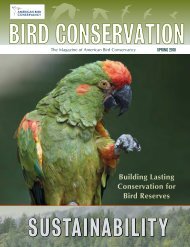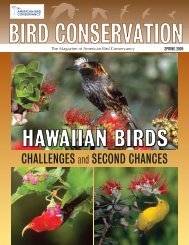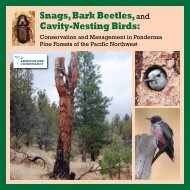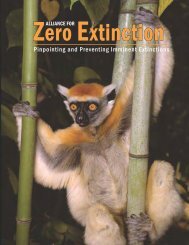Oak Ecosystems in the Pacific Northwest - American Bird Conservancy
Oak Ecosystems in the Pacific Northwest - American Bird Conservancy
Oak Ecosystems in the Pacific Northwest - American Bird Conservancy
Create successful ePaper yourself
Turn your PDF publications into a flip-book with our unique Google optimized e-Paper software.
Table 5. Projected potential bird species short-term population response to canopy management <strong>in</strong> oak habitats 1<br />
Species<br />
Canopy <strong>Oak</strong> Th<strong>in</strong>n<strong>in</strong>g 2 Canopy Douglas-fir Removal 2<br />
OFOWO OFOS OWCOS ODFOWC ODFOWO ODFOS<br />
Acorn Woodpecker o o o o o o<br />
Ash-throated Flycatcher ++++ ++++ ++++ + ++++ ++++<br />
Bewick’s Wren o o o ++++ ++++ ++++<br />
Black-capped Chickadee -- ---- ---- ++ ++ -<br />
Black-headed Grosbeak - ---- -- - -- ----<br />
Black-throated Gray Warbler - -- - --- - ---<br />
Blue-gray Gnatcatcher -- + ++++ +++ ++++ ++++<br />
Bushtit +++ ++++ +++ o +++ ++++<br />
California Towhee ++++ ++++ ++++ +++ +++ ++++<br />
Cass<strong>in</strong>’s Vireo o --- --- - --- ---<br />
Chipp<strong>in</strong>g Sparrow ++++ ++++ + + ++++ ++++<br />
Downy Woodpecker --- --- --- o o o<br />
House Wren + ++ + ++++ ++++ ++++<br />
Hutton’s Vireo - --- o o o ---<br />
Lazuli Bunt<strong>in</strong>g ++++ ++++ ++ ++ ++++ ++++<br />
Lesser Goldf<strong>in</strong>ch ++ ++++ ++++ + ++++ ++++<br />
Nashville Warbler + -- -- -- -- ----<br />
<strong>Oak</strong> Titmouse ++++ ++++ + +++ ++++ ++++<br />
Purple F<strong>in</strong>ch o o o + o +<br />
Spotted Towhee o o o o o o<br />
White-breasted Nuthatch - - o +++ ++++ +++<br />
Western Bluebird o o o o o o<br />
Western Scrub-jay + + +++ o +++ +++<br />
Western Tanager + - -- o o ----<br />
Western Wood-pewee o -- -- ++++ ++++ +<br />
1<br />
Projected potential bird species short-term population response is based on changes <strong>in</strong> mean regional density estimates. Potential is<br />
dependent on many factors beyond <strong>the</strong> actual habitat management or restoration, thus is not <strong>the</strong> expected response. Fur<strong>the</strong>r, local or<br />
ecoregional variability <strong>in</strong> species density estimates may result <strong>in</strong> different projections of change than <strong>the</strong> region-wide projections presented<br />
below. Thus, use of this table should provide an <strong>in</strong>itial projection of bird population response based on regional data that should<br />
be fur<strong>the</strong>r assessed with local data.<br />
2<br />
The degree of population response as <strong>in</strong>dicated by <strong>the</strong> number of positive (+) or negative (-) signs is used to dist<strong>in</strong>guish between species<br />
with low, moderate, or high densities where similar percent changes <strong>in</strong> density can result <strong>in</strong> different degrees of population response.<br />
For example, an <strong>in</strong>crease of 100% or doubl<strong>in</strong>g of <strong>the</strong> population from a density of 1.0 birds/ha to 2.0 birds/ha results <strong>in</strong> one new bird,<br />
whereas a 100% <strong>in</strong>crease or doubl<strong>in</strong>g of <strong>the</strong> population from a density of 3.0 birds/ha to 6.0 birds/ha results <strong>in</strong> three new birds; hence,<br />
a greater <strong>in</strong>crease <strong>in</strong> <strong>the</strong> local population. Thus, based on <strong>the</strong> criteria below, more signs <strong>in</strong>dicate <strong>the</strong> potential for greater change <strong>in</strong> <strong>the</strong><br />
actual population.<br />
+ or - = .10 change <strong>in</strong> actual density<br />
o = same density or


